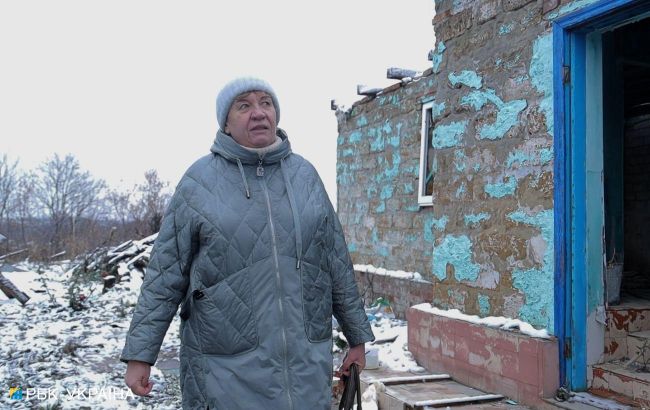Living next to enemy: How Sumy border region survives under missile strikes and drone threat
 Resident of Sumy region (all photos: RBC-Ukraine)
Resident of Sumy region (all photos: RBC-Ukraine)
During the Kursk operation, Ukraine's Defense Forces managed to push Russian troops away from the border, but the Russians found new ways to terrorize the local population. How residents of the border areas in the Sumy region live near the combat zone today - read in RBC-Ukraine report.
The Sumy region, bordering Russia, withstood the initial phase of the full-scale invasion - the Russian army was quickly knocked out from there. However, proximity to the enemy continued to disrupt the lives of those in the border zone. Cities and villages constantly suffered from artillery shelling and strikes with aerial-guided bombs. The enemy also did not abandon plans for another offensive on Sumy. Therefore, the Ukrainian Defense Forces preemptively launched the Kursk operation. Now, the Russians are attempting a counteroffensive, making this region, including the Ukrainian borderlands, one of the hottest areas of the front.
The Ukrainian military advises against traveling to one of the villages in the border zone, situated very close to the combat actions in the Kursk region. The Russians are actively deploying UAVs and strike drones here. However, on a rainy day, permission is granted - drones can barely fly in bad weather, making it a calculated risk.
The journey isn't long: it's not far from Sumy, bringing the war alarmingly close to the regional center. Along the roadside, a sign reads "Controlled Border Zone." Here, we activate the drone detector "sugar device," a familiar tool that tracks the movement of enemy UAVs. In the village, we will be at a glance for the enemy, so activating the device ensures we can quickly evacuate from the car in case of danger. If a drone approaches, everyone scatters to different places, seeking cover under trees or bushes.
The first sign that we are nearing Russia is a destroyed car on the roadside. Further on, there are several completely ruined houses. The last six months have altered the familiar landscape: there are more ruins and fewer people.
The village streets are deserted. No one is around. Last spring, locals could still be seen here, but now, those who remain stay indoors. In the village center, there used to be a large, well-stocked store: now we approach its ruins. The roof leaks rain, which trickles down shattered display windows. Miraculously, a few items remain on the shelves.
The clock is ticking for every moment captured on camera. Staying in one place for long is not an option. We move on: to a destroyed fire station, a demolished post office, and another wrecked store. The Russians have obliterated everything that could sustain life.
A local teacher is still in the village. Although the school is damaged and all the children have been evacuated, she continues teaching even during shelling. Liudmyla takes me to the basement, where there are two beds, a TV, a WiFi router, and a laptop. On the shelves, like in any good household, there are jars of preserved vegetables for the winter.
"My men set everything up for me. The internet works here, even without electric power. So, during shelling, I can continue teaching classes for the kids," says Liudmyla.

The woman explains how hard it has become to stay in the village. The Russians continuously shell the area with guided aerial bombs and various types of UAVs, targeting civilians. Unfortunately, there have been dead victims. A man, also a former teacher, was killed in his home during a strike.
Residents recount that drones fly here around the clock, sometimes dozens daily, terrorizing the population. Recently, an FPV drone struck a local family in the street.
Now, it is clear why the streets are so empty. People are too afraid to leave their homes, knowing death could be waiting outside.
One villager joined the local defense volunteer unit at the beginning of the war and now works as a combat medic. The man says he has often had to treat civilian injuries.
"When the massive shelling began, hospitals and all services evacuated. Now, no one but us can help the people," he says.
The young man adds that the situation improved after Ukraine's Kursk operation pushed the Russian army back from the border, preventing artillery from reaching border villages. However, the terror hasn't stopped: instead, the enemy uses drones and aerial bombs.
Villagers often have to defend their homes from enemy UAVs themselves. In one local man's garage, there's a collection of downed drones of various types - from large "wings" to small quadcopters. Some are even made from scrap materials like foam and cardboard, apparently assembled by students. According to the villager, drone production in Russia is streamlined, allowing the enemy to launch UAVs in vast numbers daily.
"We've shot down drones with hunting rifles, small arms, and sometimes with help from our military friends. Occasionally, electronic warfare systems jam them. We protect our homes however we can," the resident explains.

Volodymyr Artiukh, Head of the Sumy Regional Military Administration, says the Russians deliberately aim to destroy infrastructure and all facilities essential for life, trying to clear the area of its population. Meanwhile, the administration is doing everything possible to evacuate locals and save lives.
"Since the start of the Kursk operation, the use of guided aerial bombs against the Sumy region has increased hundreds of times, in total, there are 30-40 cases of combat use of these weapons per day. Last year, these were isolated cases; now, it's systematic, targeting critical infrastructure and residential areas, including private homes and apartment buildings. The goal is to demoralize the population and force them to leave," says Artiukh.
Bilopillia
The city has constantly suffered from Russian artillery shelling. The entire main street is riddled with Grad (self-propelled multiple rocket launcher - ed.) shellings. The surviving houses bear marks of shrapnel on their facades. The enemy forces are just five kilometers away.
Russian territory is clearly visible from one of the hills. Although it's overcast now, on a clear day, locals say they can observe the movement of Russian troops and the settlement of Tyotkino.
On this same hill overlooking Russia stands a ruined hut, and behind it lies a street of ruins that were once homes. Locals recall the terrifying night when the Russians heavily shelled the area with cluster munitions - using weapons against civilians that the Geneva Conventions banned.
Volodymyr Viduyev, Deputy Mayor of Bilopillia, explains that the city's position on a hill makes it an easy target for enemy attacks on the settlement and surrounding areas.
"Recently, in the border area, two men were killed due to shelling. Because of constant attacks, it was impossible to retrieve their bodies. Only after a month were the military able to evacuate them, and we buried them in a Christian way," Viduyev says.
In total, many buildings in the city have been destroyed: the school, kindergarten, cultural center, police station, and hundreds of civilian homes. The Russians even targeted the football locker room. Craters from airstrikes still scar the stadium.
The city hospital is under constant shelling. It has been hit multiple times, and in one attack, offices were destroyed and all windows shattered. However, the medical staff cannot stop working, as people with injuries seek help daily.
The doctors have adapted to the war's realities, continuing their work even under aerial bombardments. A ward for patients has been set up in the hospital's basement. Neat rows of beds are covered with clean blankets, flanked by bedside tables stocked with food and water supplies. Everything needed for patients to endure the danger is in place.
But the most critical facility lies behind the next door: an underground operating room.
"We often have to perform surgeries during shelling. People come to us with injuries, mostly caused by mines and explosions. To protect the medical staff, we conduct surgeries here in the basement," says Iryna Okhrimenko, Deputy Chief Physician of Bilopillia City Hospital.
Many elderly residents still remain in the settlement. They have lived here their whole lives and, despite the difficult situation, are unwilling to leave their homes.
On the street, I meet an elderly woman, Mrs Halyna. She and her husband survived an air bombing. An enemy aerial-guided bomb struck near their house. She takes us to a nearby home, which is completely destroyed and uninhabitable, and later leads us to her own house.

At her place, the roof has been partially repaired. Cracks run along the walls, with pieces of plaster broken off.
"I remember the terrifying explosions. It felt like the house was lifted and thrown back to the ground. Everything from the ceiling fell on our heads. My husband fell and screamed. I sneaked into the room and saw the horror," Halyna recalls.
She shares that it was a miracle they survived. In the next room, she had stored numerous icons she had embroidered with beads. Strangely, that part of the house remained untouched, without a single crack.
People in the frontline areas have to believe in miracles. They pray to the heavens that they wake up tomorrow and that no enemy bombs destroy their homes. Because the Russians deliberately target civilians.
***
The city is now covered in snow. The season that the whole world associates with Christmas holidays and winter fun has arrived. But our reality is different. As I step on the snowy surface, I hear a crunch. But it's not snow: beneath the snow lie shards of glass from houses that were once someone's homes. People here used to look forward to Christmas and admire the snowy landscapes, but now their homes have been destroyed by Russia. Perhaps the only solution is to create a buffer zone on Russian territory, so their shells can no longer reach the homes of Ukrainian civilians.

